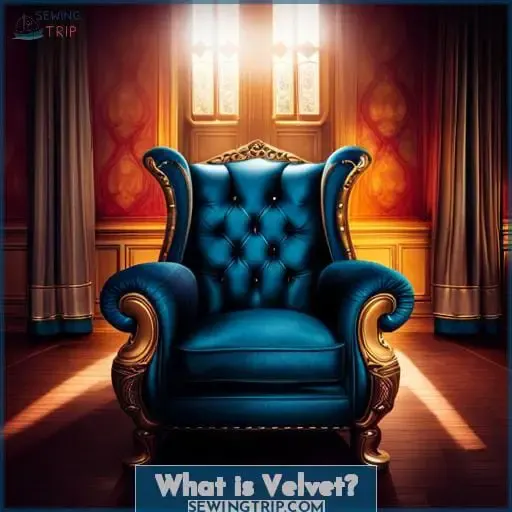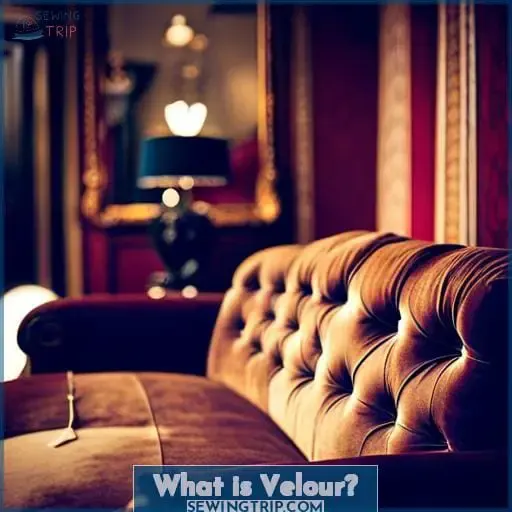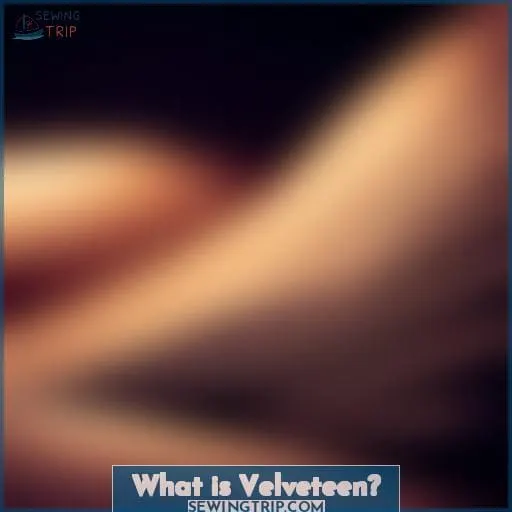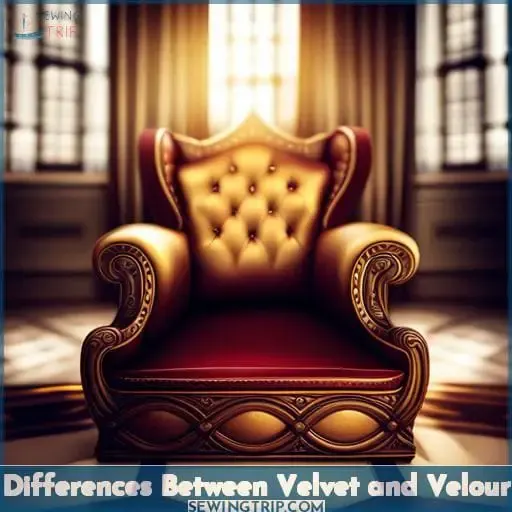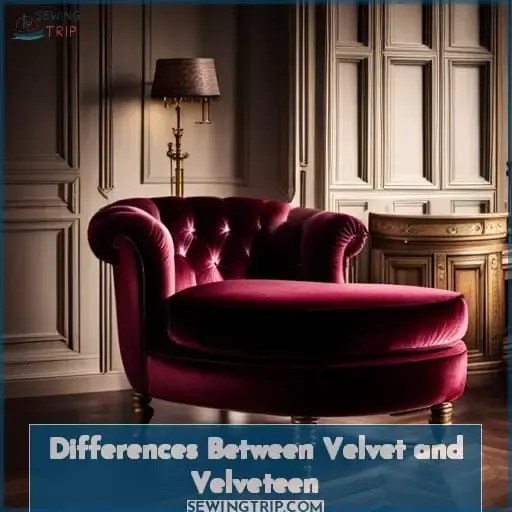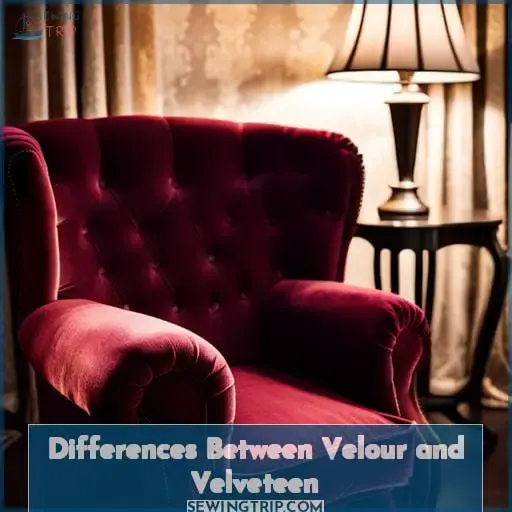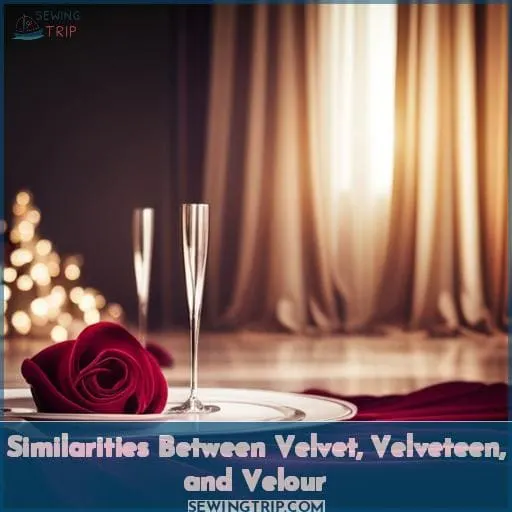This site is supported by our readers. We may earn a commission, at no cost to you, if you purchase through links.
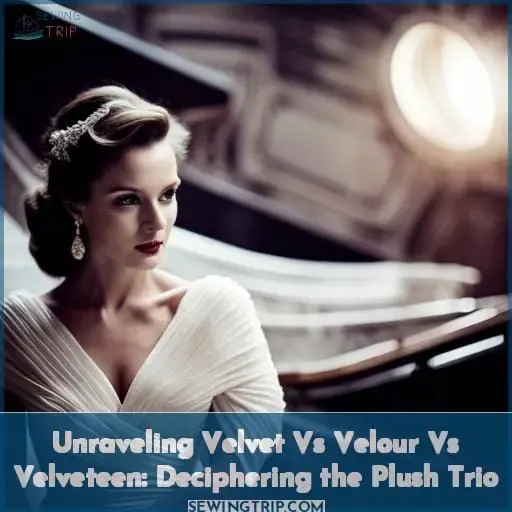 Imagine three fabrics—velvet, velour, and velveteen—wrapped around you like a warm, comforting hug.
Imagine three fabrics—velvet, velour, and velveteen—wrapped around you like a warm, comforting hug.
Velvet’s sumptuous caress, velour’s soft embrace, and velveteen’s gentle touch—they’re like cherished friends, each with their own unique charm.
But what sets them apart?
Let’s unravel the plush trio, deciphering their differences and similarities, so you can confidently choose the perfect fabric for your next creation.
Table Of Contents
Key Takeaways
- Velvet has a luxurious sheen, while velveteen has a subtle luster.
- Velvet has a plush, standing pile, but velveteen has a short, flat nap.
- Velvet drapes gracefully, but velveteen holds its shape well.
- Velvet feels smooth when stroked downward, but velveteen has a rougher texture.
What is Velvet?
Since you’re wondering what velvet is, it’s a luxurious fabric made primarily from polyester, rayon, and silk.
It has a longer pile that creates a standing effect.
Woven on rods and then cut to create loops, velvet’s plush texture is often used for upholstery, drapery, and evening wear, exuding elegance and sophistication.
Its characteristics include a soft, smooth feel downward and a rougher feel upward, making it a delight to touch.
Velvet’s rich colors and luxurious shine add depth and dimension to any space, making it a popular choice for creating a sense of intimacy and safety.
Whether you’re seeking comfort or style, velvet’s timeless appeal and versatility make it a perfect choice for those seeking a touch of luxury and warmth.
What is Velour?
Velour, a plush knitted fabric, greets you with its distinctive softness, beckoning you into its embrace of comfort. Unlike velvet, its stretchy nature allows it to caress your body with a gentle hug, conforming to your every move.
This luxurious fabric drapes beautifully, much like velvet, yet it maintains its own unique charm.
Velour’s versatility extends beyond its comfort, making it a favorite for casual wear and home décor alike. Its soft and inviting texture entices you to sink into its plushness, whether you’re lounging in a cozy hoodie or adorning your living room with velvety pillows.
While velour shares similarities with velvet and velveteen, it stands out with its medium pile, a characteristic that falls between velvet’s luxurious height and velveteen’s subtle shortness. This unique feature grants velour its own distinctive flair, setting it apart from its plush counterparts.
What is Velveteen?
Meet velveteen, the cotton-silk’s faux velvet cousin.
Woven tightly with a short pile, it’s a sturdy fabric that mimics velvet’s luxuriousness at a more budget-friendly price.
Velveteen finds its niche in structured garments, upholstery, and home accessories.
Its dense texture holds its shape well, making it suitable for tailored pieces like blazers and A-line skirts.
Care for velveteen with gentle hand-washing or dry cleaning to maintain its integrity.
Sewing velveteen requires precision; use fine needles and pins to avoid snags.
Explore crushed velvet and corduroy as plush alternatives.
Differences Between Velvet and Velour
In comparing velvet and velour, you’ll find contrasts in shine, stretchiness, thickness, and perceived value.
Velvet’s luxurious sheen exudes elegance, while velour’s duller finish lends a more casual vibe.
Velour’s inherent stretchiness allows for a comfortable fit and ease of movement, unlike velvet’s structured drape.
The thickness of velvet adds a touch of grandeur, whereas velour’s thinner profile offers a more relaxed feel.
Lastly, velvet’s reputation for luxury often commands a higher price tag compared to velour’s affordability.
- Velvet’s sheen captivates with a luxurious allure, while velour’s finish remains understated.
- Velour’s stretchy embrace conforms to your every move, unlike velvet’s unyielding structure.
- Velvet’s plush thickness exudes opulence, while velour’s svelte profile offers a relaxed charm.
- Velvet’s exclusivity often commands a premium, while velour’s accessibility makes it a budget-friendly choice.
Differences Between Velvet and Velveteen
Dive into the distinctive traits that set velvet apart from velveteen.
Velvet’s plush, standing pile dwarfs velveteen’s short, flat nap, granting it an unmatched luxuriousness.
Velvet’s graceful drape contrasts with velveteen’s structured rigidity, adding versatility to your creative projects.
Material composition also varies: velvet often blends cotton, silk, and synthetics, while velveteen typically relies on cotton or cotton-silk blends.
Velvet’s captivating sheen outshines velveteen’s subtle luster, adding a touch of glamour to any ensemble.
Finally, velvet’s smooth downward caress contrasts with velveteen’s rougher texture, inviting you to experience their textural nuances.
Differences Between Velour and Velveteen
Velour’s knit structure contrasts with velveteen’s woven construction.
Velour’s pile lies flatter, akin to corduroy’s distinct ridges, while velveteen’s pile stands upright, creating a plush, velvety texture.
Velour’s inherent stretchiness allows for greater flexibility and comfort, unlike velveteen’s structured, non-stretchy nature.
In terms of draping characteristics, velour’s inherent drape lends itself to flowing silhouettes, while velveteen’s lack of drape makes it ideal for structured garments and home accessories.
Their manufacturing processes also differ: velour is knitted, while velveteen is woven.
Material composition varies too; velour is typically a cotton-blend or polyester, while velveteen often incorporates cotton or cotton-silk blends.
Care tips diverge as well: velour prefers cool, gentle washes or handwashing, while velveteen favors dry cleaning.
So, your choice between these plush fabrics hinges on the desired texture, drape, manufacturing method, material composition, and care preferences.
Similarities Between Velvet, Velveteen, and Velour
Velvet, velveteen, and velour share some key commonalities despite their unique fabric characteristics:
- Luxurious appearance from cut pile
- Soft texture with sheen
- Drapes well, unlike many other fabrics
Though they differ in pile length and height, manufacturing process, and end uses, all three fabrics share an elegant, plush aesthetic from their signature cut pile construction.
With proper care, they maintain their beautiful look and indulgent hand across time, bringing comfort and sophistication to any wardrobe or decor.
Understanding the nuances between velvet, velveteen, and velour allows you to best leverage their shared magnificence.
Frequently Asked Questions (FAQs)
What types of clothing is velveteen best suited for?
Velveteen is well-suited for structured clothing like jackets, pants, and skirts.
Its sturdy pile lies flat, mimicking velvet’s look without the drape.
Velveteen’s density also makes it ideal for upholstery and home accessories requiring shape and form.
Is velvet machine washable?
Friend, inspect the velvet delicately.
Though glamorous, its soft fibers long for gentleness: limit washing to professionals or use air.
Exceptions blossom for hardy velvets – yet exercise care as nicks tear hearts like yours.
Breaking velvet’s spirit pains me too; rather, let’s swaddle it gently in appreciation.
How do you clean velvet furniture or upholstery?
Vacuum velvet furniture regularly with a soft brush attachment.
Spot clean stains immediately with a damp microfiber cloth and mild detergent.
Steam velvet upholstery every few months to refresh the pile.
Avoid rubbing or soaking velvet as water can damage the fabric.
Handle velvet gently when cleaning.
What are some alternative care methods for velvet, velveteen, and velour fabrics besides dry cleaning?
Carefully spot-clean velvet or velveteen using a soft brush and gentle upholstery cleaner.
For velour, flip the fabric inside-out and hand wash in cool water with a mild detergent.
Allow all fabrics to fully air dry to prevent pile distortion.
Handle with care.
Are there any tricks for preventing pilling with velveteen or velour fabrics?
Use a sharp razor to gently shave pills as they appear.
Wash garments inside-out and line-dry to minimize friction.
Consider applying a thin layer of clear nail polish to high-friction areas before wearing.
Handle garments gently and avoid overloading the washer to reduce agitation.
Conclusion
Enveloped in velvet’s luxurious caress,
Velour’s tender embrace,
And velveteen’s gentle touch,
You’re wrapped in their distinctive charm.
Though unique, these fabrics share
A plush, comforting quality.
Discerning their nuances allows you to choose
The perfect one to fulfill your vision.
With velvet’s opulence,
Velour’s softness,
And velveteen’s affordability,
You can find the ideal fabric to bring your creation to life.

